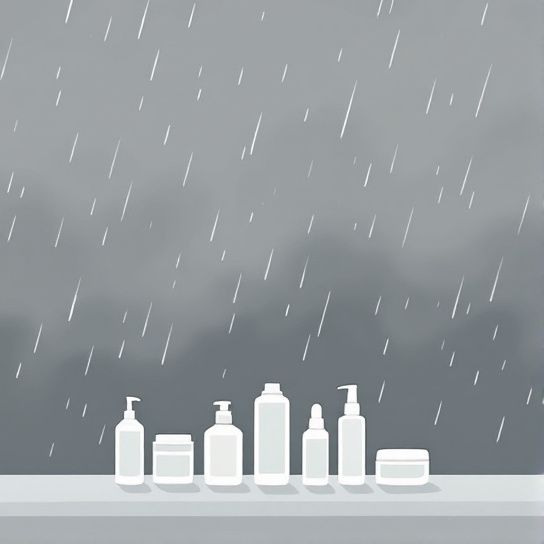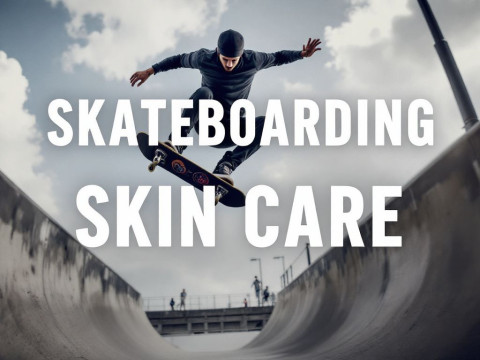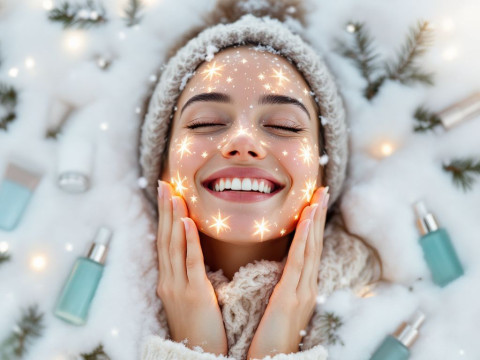You know that crisp, breezy feeling in the air? Yup, fall is here! And with it, those delightful winds that make your cheeks feel like they’ve been kissed by the universe. Or, and let’s be honest here, more like slapped around a bit. That wind might feel fresh and invigorating, but here’s the deal: it’s not just the colorful leaves dying out there. Your skin is silently crying for help too. Wind exposure can do a number on your face, and not in a cute, rosy way. Is your skin feeling a tad distressed?
Let’s dive into this easy-going yet powerful guide on managing skin stress with the change of seasons. We’ll chat on everything from the wayward wind’s effect on climate acne to practical tips on fighting those pesky seasonal elements.
Understanding the Fall Wind’s Effect on Your Skin
You might be wondering, “Why is fall wind such a bully to my skin?” Great question. Wind exposure strips the skin of its natural oils, leaving it dry and prone to irritation. Imagine your skin as a magical shield, working hard to protect you, and the wind is kinda like this invisible agitator, poking and prodding holes through it. Over time, this battle leaves your skin more sensitive, leading to issues like climate acne – yep, the elements can team up to wreak havoc on your face.
Think of it as a double-whammy. Not only does the wind dry out your skin, but the mixture of outdoor chill and indoor heating creates a moisture-stealing tag team you’re up against all season. Each element does its mischief; the wind, for instance, is known for stirring up climate acne by encouraging clogged pores and dull skin.
What Is Climate Acne, Anyway?
Climate acne. Does that sound strangely specific and daunting? Well, it kinda is. Say you’re soaking up that crisp fall air, and suddenly, bam! Breakouts. Climate acne happens when changes in environmental conditions, like sudden temps and humidity shifts, cause an imbalance in your skin’s natural oil production. More drying wind means more oil production as your skin desperately tries to adjust and hydrate itself, eventually leading to those unwanted zits. Sigh, I know.
Ever notice how your skin feels tight and shiny all at once as you dash from your jack-o’-lantern-lined street to your cozy, heated home? Inside, the warmth opens up your pores. On the streets, that brisk wind contracts them. This cycle invites climate acne to the unprepared. Lesson? Prepare!
Nature’s Challenge: How Wind Affects Skin Barrier Function

Let’s talk about your skin’s shield, shall we? The barrier we’re chatting about is like the skin’s defense force against this crazy whirlwind world. When the wind swoops in unapologetically, it disrupts this oh-so-important barrier, making your skin vulnerable (ever felt that raw-ish feeling on a particularly windy day?).
Dry and Dehydrated Skin Dilemmas
You’ve heard of dehydration, right? Water loss. Picture applying that concept directly to your skin. What happens is that the wind actually speeds up the evaporation of water from these outer layers. Lovely. The drier your skin, the weaker your defense. And that’s not some quirky myth! Dryness can evolve into flakes, redness, and more severe climate acne. Even people not usually prone to acne might find an uninvited blemish or two waving back at them in the mirror.
Adding insult to seasonal injury, frequent dehydration causes your skin to break, quite literally, in its tiny moisturizing dams, leading to those classic flaking concerns you’ve likely battled before. Sudden cold snaps don’t help, thrusting your skin from one extreme to another, encouraging oil glands to overcompensate and eventually causing blockages.
Fall Wind Skin Survival Kit: Essentials You Need
But fear not, my wind-harried friend. Smart skin care tailored for this blustery Fall limelight can defend your skin. Here’s a down-to-earth collection of essentials you’re going to want in your skincare routine. And trust me, a little planning makes for a whole lot of glowing.
Moisturizer to the Rescue
Do yourself the kindest favor: double your moisturizing efforts. Aim for a super hydrating, but non-greasy moisture powerhouse. By forming a protective layer on your skin, it helps stave off climate acne while sealing in precious moisture. Remember to gentle-lean into those rich creams if your skin can handle them without clogging up your pores.
How to Moisturize Effectively:
- Layer Up: Apply a hydrating serum followed by a robust cream to trap maximum moisture.
- Try Adding Oils: Facial oils can offer a brilliant barrier effect.
- Keep it Light: During the day, still opt for lighter, non-comedogenic formulas to avoid unwelcome pore blockages.
Sunblock Isn’t Just for Summer
Sunscreen, ah yes, the sometimes-forgotten warrior in the cooler months. UV rays are ever-present. Don’t dawdle; protect your face with a layer of at least SPF 30. Remember, integrating sunblock fights off any potential irritation aggravated by the wind. Don’t believe me? Just watch how your skin appreciates the gesture.

Exfoliate… But Carefully!
Now, hang on a sec! I’m not suggesting a vigorous scrubfest. Gentle is the keyword here. Your skin may be naturally more sensitive during windy times, so healthcarefully choose formulas like lactic or glycolic acid, which work great for a smoother surface without being too harsh. Gentle exfoliation assists shedding of the flakiness that could exacerbate climate acne, so keep exfoliating in balance.
Tweak Your Skincare Ritual with Season
You don’t need to overhaul your entire skincare shelf, but definitely fine-tune your products. Switch summer gels for creams, remove harsh toners, and say sayonara to anything giving the deep clean feel if it involves skin-tightness or irritation thereafter. Listen to your skin. Feel! It’s like how some days you need a comfy sweater but not others, right?
Protect & Prevent Components
- Wear a Windbreaker or Scarf: Covering your face slightly delays the direct abrasive effect when windy.
- Masks with Essentials: Try hydrating or soothing face masks with ingredients like aloe, calendula, or ceramides.
- Keep the Lip Balm Handy: Your lips are exceptionally vulnerable; a little chapstick saves them from cracking.
Weatherproof Strategies: Lifestyle Adjustments to Consider
Even beyond lotions and potions, our lifestyle decisions affect climate acne. Shifting a few habits boosts skin resilience, promise.
Humidifier in the Home
Housing hack: crank up your indoor moisture. That indoor heating is boss-level cozy but strips air moisture. Solution? Humidifiers restore what the wind swipes, tackling it sneakily at home-base.
Stay Hydrated

Flip open that thermos; hotter drinks warm up the soul! Hydration is a sneaky player keeping skin happy. Drink that water. Seriously, it counters dryness head-on. Cozy teas can be your heroic buddies in this season-long saga.
Balanced Nutrition
Fall foods can aid your skin’s defense. Up your intake of omega-rich foods like flaxseed and walnuts while vitamin-packed seasonal stuff, such as squash and sweet potatoes, work wonders internally with antioxidants for pretty squirrel-versus-acorn anti-inflammatory woodcut vibes.
Fall ReCovery: Handling Wind-Damaged Skin
Already feeling defeat from previous weeks? Snap right back into the self-care mindset. Wind can be relentless, but your skin? It has potential. Repair mode requires bedding down with calmer ingredients.
Restore and Rebuild
Pick soothing, calming skincare like aloe-based creams or chamomile magic. Steer clear of anything with the trend word “peel” for a moment. Approach your skin with a tender head pat.
Nighttime Recovery Rituals
Stress less. There’s reassurance in practicing a gentle routine come twilight: cleanse, moisturize deeply, and opt for an overnight mask. Your skin hydrates deeply as you morph under starry night dreams.
Seek Professional Advice If Needed
Stubborn climate acne stick-arounds? Consult a dermatologist. Personalized solutions from seasoned experts can sometimes rally results otherwise elusive on lone endeavors. No shame in this game.
Wrapping up, navigating your care routine amidst cool fall winds can indeed feel like balancing several spinning plates—wind here, disfavorable humidity there. Remember, the keyword in this skincare circus is “consistency.” Oh, and patience too; be gentle with yourself as every season, and skin, holds different patterns. We owe it kindness and a layer of good moisturizer, doncha think? Go forth, find those beauty treasures adaptable for autumn adventures, and glow warmer than a golden leaf pile! 🌬️🍁
Frequently Asked Questions
How does climate change affect acne?
Climate change can exacerbate acne through several mechanisms. Warmer temperatures and increased UV radiation can stimulate the growth of *Cutibacterium acnes* (formerly known as *Propionibacterium acnes*), a bacteria associated with acne. Additionally, changes in temperature and humidity can increase sebum levels and pilosebaceous unit swelling, leading to acne flares[1][4].
What specific climatic factors contribute to acne flares?
Specific climatic factors such as increased UV radiation, higher temperatures, and humidity play significant roles in acne flares. UV radiation can lead to hyperplasia of sebaceous glands, while warmer temperatures increase sebum levels and humidity causes pilosebaceous unit swelling. These changes create an environment conducive to the growth of *C. acnes* and subsequent inflammation[1][4].
How do seasonal changes impact acne?
Seasonal changes can significantly impact acne. During the transition from warm to cold weather, dry air can lead to overproduction of sebum, causing winter acne. Conversely, humid air in warmer seasons can trap oil on the skin’s surface, creating an environment where acne-causing bacteria thrive. These seasonal variations require adjustments in skincare routines to manage acne effectively[3][5].
What other environmental factors besides climate change can affect acne?
Besides climate change, other environmental factors such as air pollution, exposure to industrial pollutants like coal tar or crude oil, and even the use of electronic products can affect acne. Air pollution increases oxidative stress and alters skin lipid functions, while industrial pollutants can obstruct sebaceous follicles. Additionally, visible light from electronic devices can increase the proliferation of bacteria that contribute to acne[2][4].
References










